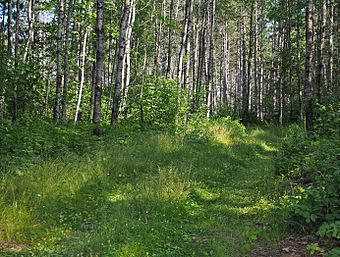Height of Land Portage (St. Louis County) facts for kids
Quick facts for kids |
|
|
Height of Land Portage
|
|

A modern snowmobile trail along the portage route
|
|
| Location | Off County Road 138 in Embarrass, White, and Pike Townships, Minnesota |
|---|---|
| Area | 163.2 acres (66.0 ha) |
| Built | c. 1630s–1870s |
| MPS | Portage Trails in Minnesota MPS |
| NRHP reference No. | 92000842 |
| Added to NRHP | July 23, 1992 |
The Height of Land Portage is a special historic trail in St. Louis County, Minnesota. It connects two rivers, the Embarrass River and the Pike River. This trail is about 4.6-mile (7.4 km) long.
This portage was super important for travelers from the 1630s to the 1870s. It helped people move between two huge water systems. These are the Hudson Bay drainage basin and the Great Lakes Basin. Because of its history, the Height of Land Portage was added to the National Register of Historic Places in 1992.
Contents
What is a Portage?
A portage is a path over land that connects two bodies of water. Imagine you are traveling by canoe. You reach the end of one river, but you need to get to another river to continue your journey. You can't paddle your canoe over land!
So, you would carry your canoe and all your supplies across the land. This act of carrying is called "portaging." Portages were vital for explorers and traders in the past. They allowed them to travel long distances by water, even when rivers didn't connect directly.
Crossing the Laurentian Divide
The Height of Land Portage crosses something called the Laurentian Divide. A "divide" is like a high ridge of land. It separates areas where water flows in different directions. Think of it as a giant natural split.
- On one side of the Laurentian Divide, all the rain and melted snow eventually flow north. This water ends up in the huge Hudson Bay in Canada.
- On the other side, the water flows south or east. This water eventually reaches the Great Lakes and then the Atlantic Ocean.
So, this portage was a key spot. It was one of the few places where people could easily cross from one major water system to another.
A Hub for Early Travelers
For over 200 years, the Height of Land Portage was a busy pathway. It was used by many different groups of people:
- Native Americans: Long before Europeans arrived, Indigenous people used these trails. They knew the land well and used portages for travel and trade.
- Fur Traders: In the 1600s and 1700s, European fur traders came to North America. They wanted to trade with Native Americans for animal furs. These furs were very valuable in Europe. The portage was a crucial link for them to transport furs and supplies.
- Explorers: As Europeans explored more of North America, they used portages to map new territories. They were looking for new trade routes and resources.
The portage helped with the "European expansion" into North America. This means it played a role in how Europeans moved into and settled new areas.
Why is it Historic?
The Height of Land Portage is important for several reasons:
- Archaeology: The trail might hold clues about the past. Archaeologists can study the area to find old tools, campsites, or other signs of the people who used the portage centuries ago.
- Exploration and Settlement: It shows how early explorers and settlers moved through the wilderness. It helped open up new areas for trade and living.
- Transportation: It was a key part of the transportation network of its time. Before roads and trains, portages were like highways for canoe travel.
Being on the National Register of Historic Places means it's a special place. It's recognized for its importance to the history of Minnesota and the United States.



